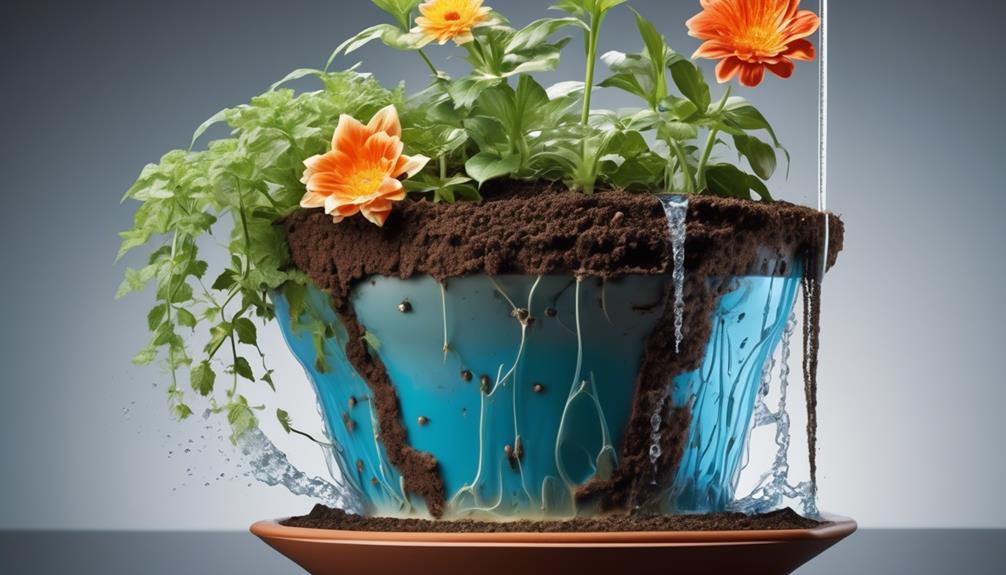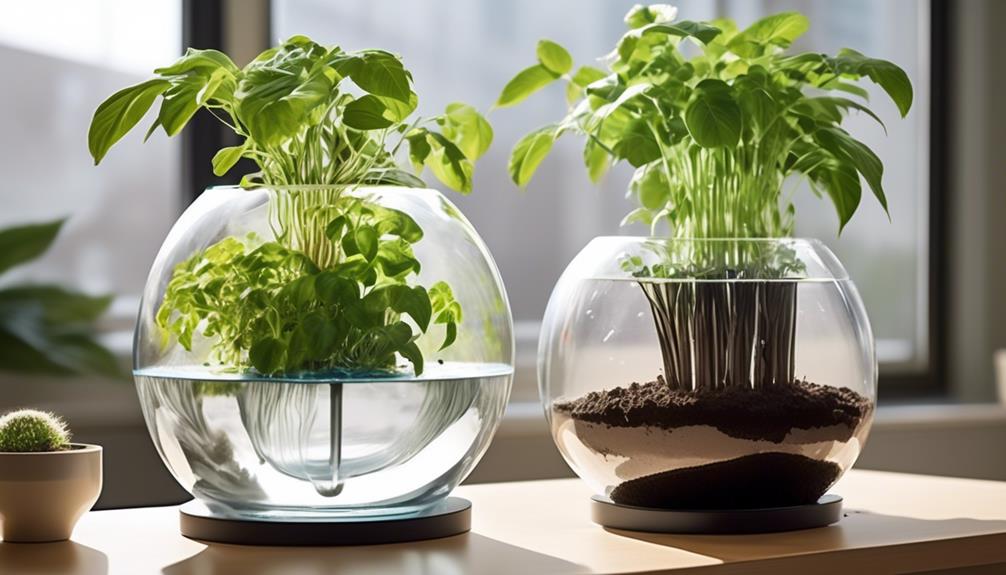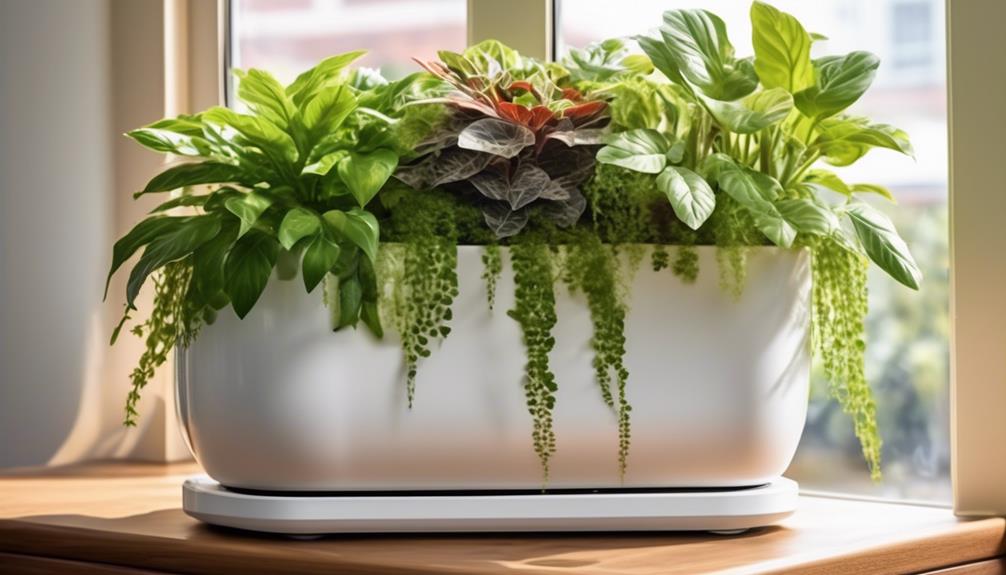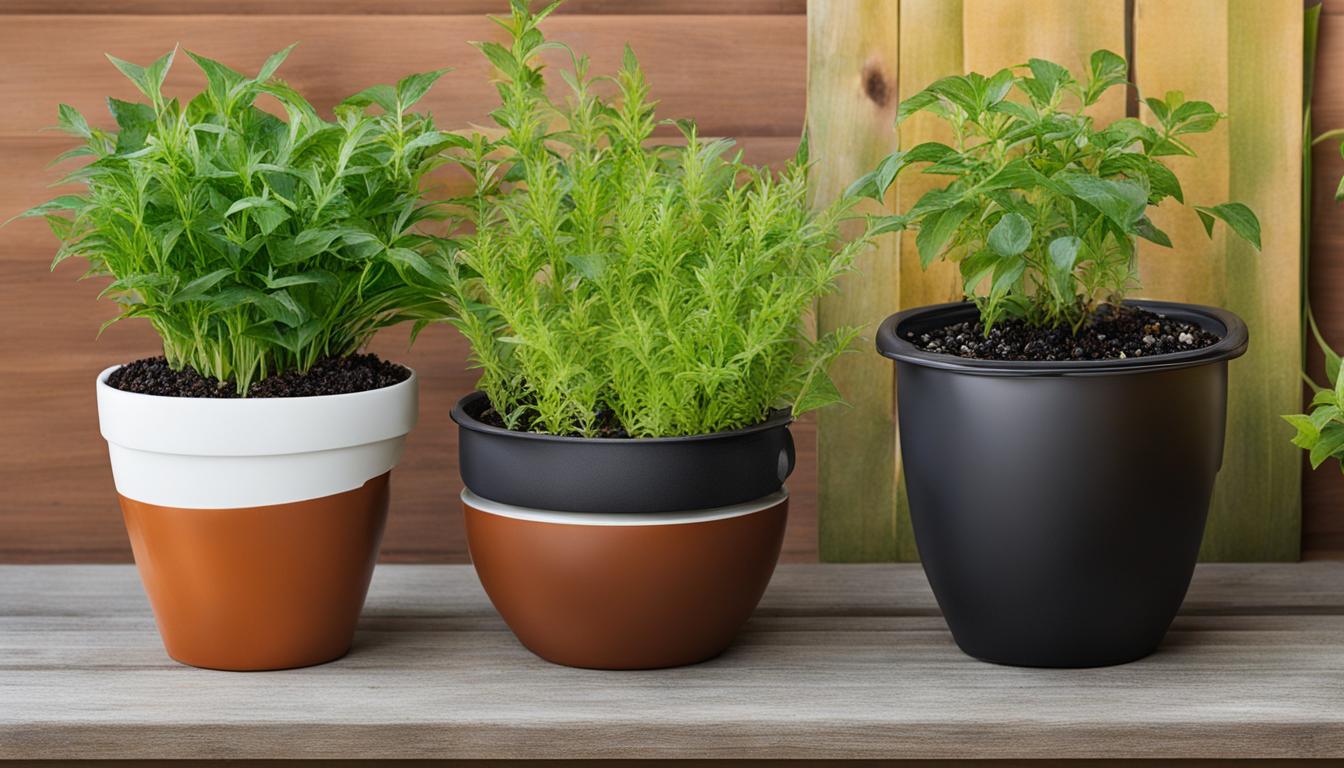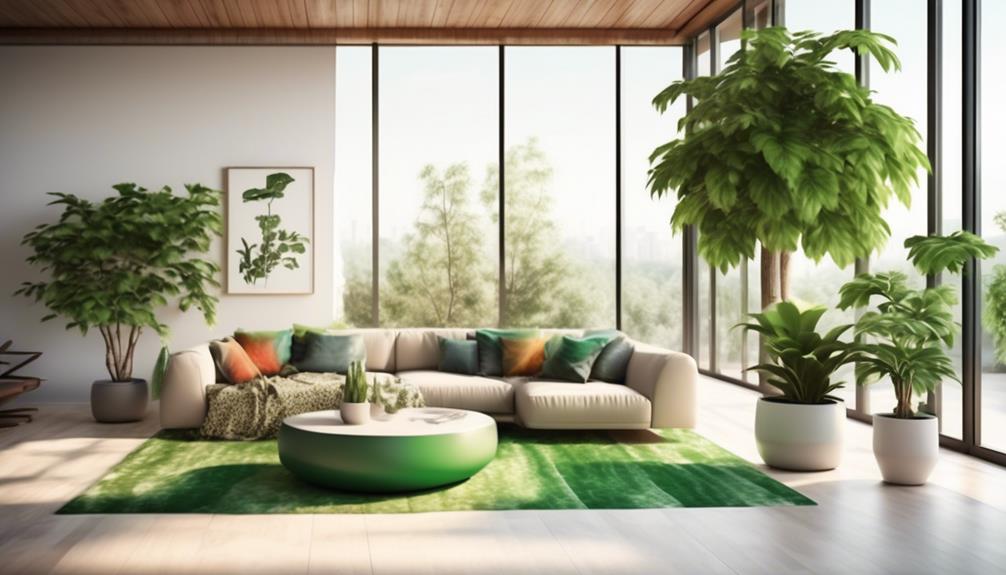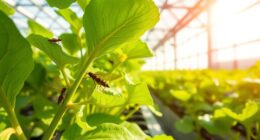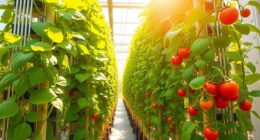Have you ever thought about how self-watering planters work to help your plants thrive with minimal maintenance? These innovative pots rely on fascinating and effective scientific concepts like capillary action, reservoir systems, and a wicking technique to make sure that water is delivered directly to the plant roots.
But there's more to it than meets the eye. Understanding the intricate workings of self-watering pots can shed light on how to optimize their performance and ensure your plants receive the perfect amount of moisture.
Key Takeaways
- Capillary action and wicking materials play a crucial role in water distribution to plant roots in self-watering pots.
- The reservoir system and water level indicator ensure even water distribution and prevent overwatering or underwatering.
- Aeration and oxygen exchange in self-watering pots promote root health, prevent waterlogging and root rot, and support optimal growth.
- Self-watering pots provide controlled moisture levels, simplify watering, enhance nutrient absorption, and promote healthy root development and overall plant growth.
Capillary Action
Capillary action is the process by which water moves up through a narrow space, such as the soil in a self-watering flower pot, due to the combined forces of adhesion and cohesion.
This phenomenon is crucial for the functioning of self-watering pots, as it enables water retention and moisture control within the soil.
When the soil in the pot is in contact with water, the water molecules adhere to the surface of the soil particles. Simultaneously, cohesion causes the water molecules to stick together, forming a column of water.
As the soil is composed of tiny particles, the water is drawn up through the narrow spaces between them, defying gravity. This is due to the adhesive forces between the water and the soil particles being stronger than the gravitational pull, allowing the water to rise.
Consequently, capillary action ensures that the soil in the self-watering pot remains consistently moist, providing an optimal environment for plant growth.
Understanding this process is essential for maintaining an effective self-watering system, as it directly influences the plant's access to water and nutrients.
Reservoir System

The effectiveness of the self-watering flower pot's capillary action in maintaining consistent soil moisture is directly attributed to the design and function of the reservoir system. The reservoir system is a crucial component that ensures the continuous supply of water to the plant's roots.
Here's how it works:
- Reservoir Capacity: The size of the reservoir directly impacts the frequency of refilling. A larger capacity means less frequent refills, while a smaller capacity requires more frequent monitoring and refilling.
- Water Level Monitoring: The reservoir system typically includes a water level indicator, allowing users to easily monitor the water level without the need to disrupt the plant or soil. This ensures that the plant never runs out of water.
- Water Distribution: The design of the reservoir system is optimized to distribute water evenly throughout the soil, providing consistent moisture to the plant's roots.
- Oxygenation: Proper reservoir design also considers oxygenation of the water to prevent stagnation and promote healthy root growth.
The reservoir system's capacity and functionality are critical in ensuring that the self-watering flower pot effectively maintains the plant's moisture levels, promoting healthy and thriving plant growth.
Wicking Mechanism
The wicking mechanism in self-watering flower pots operates through capillary action, where water is drawn up through the porous material of the wick.
Different materials, such as cotton or nylon, can be used for the wicking process to effectively distribute water to the plant's roots.
Understanding the water distribution process within the wicking mechanism is crucial for optimizing the self-watering system's efficiency.
Capillary Action Explanation
Using a woven material, water is drawn upward through the soil to keep the plant roots hydrated in self-watering flower pots. Capillary action, also known as wicking, is the process by which water moves through small spaces in a porous material, such as soil or fabric, due to the forces of adhesion and cohesion.
This mechanism ensures efficient water distribution and plant hydration by allowing moisture to move from the reservoir to the root zone as needed. The capillary action in self-watering pots is driven by the cohesive and adhesive properties of water, enabling it to defy gravity and move against the force of gravity.
As a result, the plant roots have continuous access to water, promoting optimal growth and reducing the risk of overwatering or underwatering.
Materials for Wicking
Wicking materials, such as felt or nylon, play a crucial role in facilitating the capillary action necessary for self-watering flower pots to effectively distribute water to the plant roots. These materials are selected based on their ability to retain moisture and transport it to the plant roots.
Felt, a commonly used wicking material, possesses excellent moisture retention properties, ensuring that water is consistently available to the plant. Additionally, materials like nylon exhibit high capillary action, drawing water from the reservoir to the soil as needed.
The choice of wicking material also impacts watering frequency, as materials with superior moisture retention capabilities can extend the time between refills. By carefully selecting wicking materials based on their moisture retention and capillary action, self-watering pots can efficiently regulate watering frequency, providing optimal conditions for plant growth.
Water Distribution Process
To facilitate the efficient distribution of water in self-watering flower pots, the wicking mechanism employs capillary action to transport moisture from the reservoir to the plant roots. Capillary action, driven by the cohesive and adhesive properties of water, allows it to move through narrow spaces, such as the wick, against the force of gravity. This process ensures optimal watering efficiency and promotes consistent plant hydration.
The wick, typically made of materials like cotton, felt, or nylon, draws water from the reservoir and delivers it to the root system. As the plant consumes water, the wicking mechanism continuously replenishes moisture, maintaining ideal soil moisture levels. This mechanism helps prevent overwatering, root rot, and ensures that the plant receives water as needed for healthy growth.
Soil Moisture Control
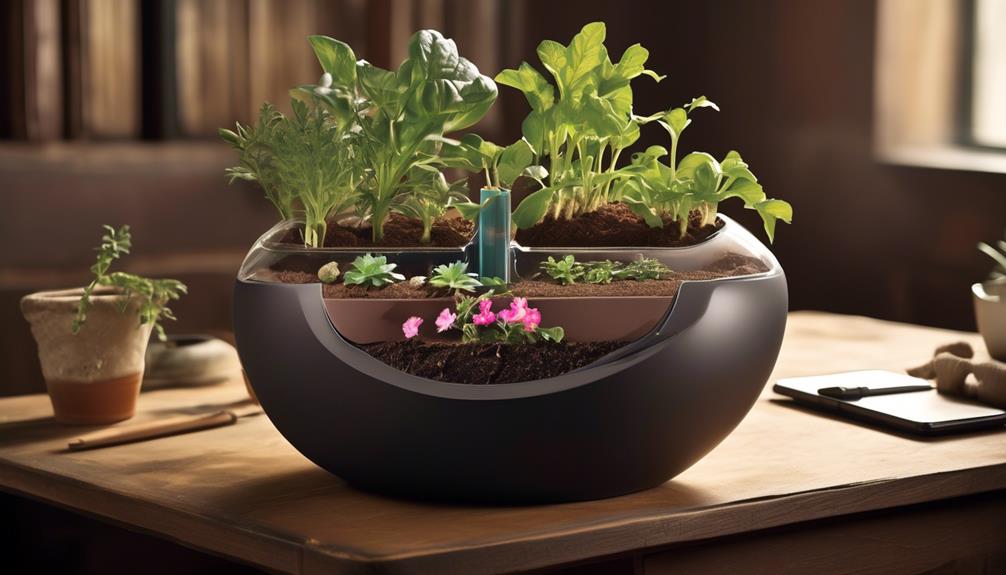
An effective method for regulating soil moisture in self-watering flower pots involves the use of a capillary action system to manage water distribution within the potting medium. This system relies on the principles of water retention and moisture regulation to ensure optimal growing conditions for plants.
The potting medium, typically a combination of peat, vermiculite, and perlite, has the ability to retain water, crucial for maintaining consistent moisture levels.
The capillary action system utilizes wicks or porous material to draw water from a reservoir into the potting medium. As the potting medium absorbs water, it creates a moisture gradient, ensuring that the entire root zone remains consistently moist.
This controlled moisture level is vital for plant growth, preventing both waterlogging and drought conditions. The capillary action system efficiently manages soil moisture, providing plants with a steady supply of water as needed.
This mechanism enables self-watering flower pots to sustain healthy plant growth by maintaining an optimal balance of water and air in the root zone, essential for robust and flourishing plants.
Root Absorption

The capillary action system, facilitating consistent moisture levels in the potting medium, directly impacts the process of root absorption in self-watering flower pots. This mechanism allows for a steady flow of water from the reservoir to the potting medium, creating an ideal environment for roots to thrive and efficiently absorb water and nutrients.
- Root Health: The self-watering system promotes robust root development by ensuring a consistent supply of moisture, reducing the risk of overwatering or underwatering, which can both have detrimental effects on root health.
- Nutrient Absorption: The controlled moisture levels in self-watering pots facilitate optimal nutrient uptake by the roots, enhancing the overall health and vitality of the plant.
- Osmosis and Diffusion: The capillary action drives water and dissolved nutrients upward through the potting medium, supporting osmosis and diffusion processes crucial for root absorption.
- Aeration: Proper moisture levels in the potting medium promote adequate aeration, preventing waterlogged conditions that could impede the roots' ability to absorb oxygen and nutrients.
This self-regulating system not only simplifies watering for plant caregivers but also plays a critical role in promoting root health and efficient nutrient absorption, contributing to the overall success of the plants being cultivated.
Evaporation Prevention
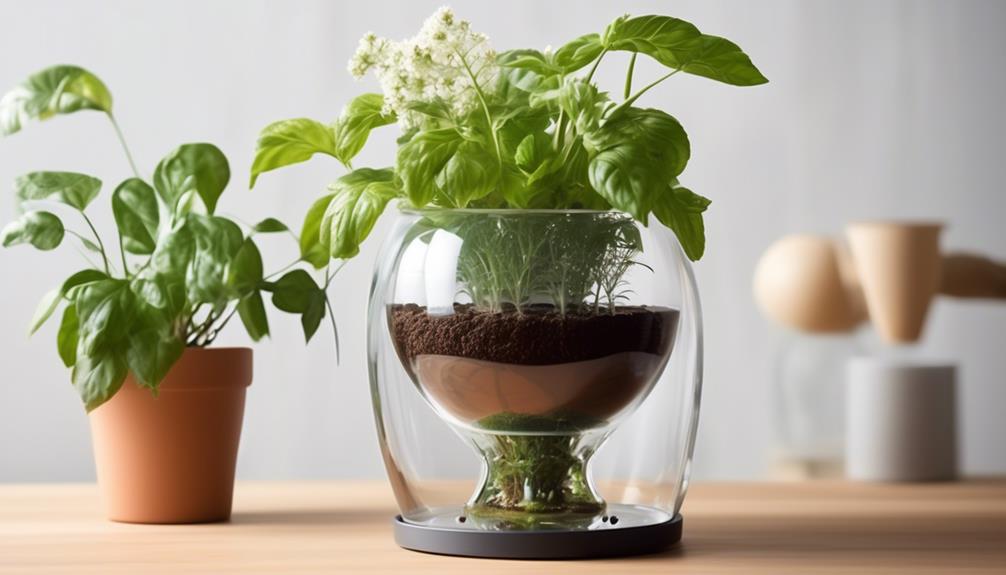
Preventing evaporation is essential in self-watering pots to maintain optimal moisture levels and support plant growth. Evaporation from the soil surface can lead to water loss, especially in arid environments or during hot weather. To combat this, self-watering pots are designed to minimize evaporation and promote water conservation through innovative mechanisms.
| Evaporation Prevention Methods | Description |
|---|---|
| Reservoir System | Self-watering pots feature a reservoir that holds excess water, preventing it from evaporating and keeping it available for plant uptake. This ensures consistent moisture levels in the soil. |
| Wicking Mechanism | A wick, typically made of fabric or rope, extends from the reservoir into the soil. This capillary action allows water to gradually move upward, ensuring efficient moisture retention and distribution to the plant's roots. |
| Soil Covering | Some self-watering pots come with a soil cover or mulch layer, which acts as a barrier against evaporation. This covering minimizes direct exposure of the soil to air, reducing moisture loss and supporting plant growth. |
Water Level Indicator

Developing a water level indicator is crucial in self-watering pots as it allows for accurate monitoring of the reservoir's water supply, ensuring optimal hydration for the plants. The water level indicator functions as a vital component in maintaining the balance of water in the reservoir, directly impacting the watering frequency and plant health.
Here are the key aspects of a water level indicator:
- Precision: The water level indicator provides precise measurements of the water level in the reservoir, enabling users to determine when refilling is necessary.
- Monitoring: It allows for continuous monitoring of the water level, ensuring that the plants receive a consistent water supply, essential for their health and growth.
- Indication: The indicator visually displays the water level, making it easy for users to assess the reservoir's status at a glance.
- Optimization: By facilitating the maintenance of an optimal water level, the indicator contributes to the overall health and well-being of the plants, preventing both overwatering and underwatering.
The water level indicator is an indispensable tool in self-watering pots, effectively contributing to the overall success of the self-watering system.
Aeration Chamber
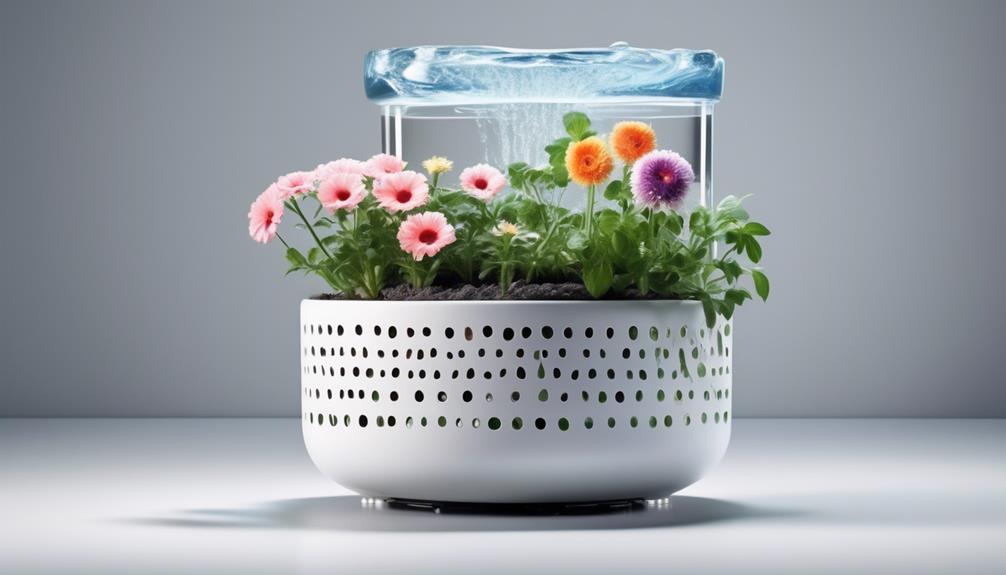
As the plants in self-watering flower pots grow, they require proper aeration for their root health.
The aeration chamber within the pot facilitates the oxygen exchange process, allowing the roots to respire effectively.
This promotes healthier and more robust plant growth by ensuring that the roots have access to the oxygen they need.
Aeration for Root Health
In self-watering flower pots, the aeration chamber facilitates root health by promoting oxygen exchange and preventing waterlogging. This is crucial for optimal root growth and plant hydration.
The aeration chamber operates by creating a balanced environment within the soil, ensuring that roots receive an adequate supply of oxygen. This is achieved through the movement of air between the soil and the reservoir, preventing the buildup of excess moisture which can lead to root rot.
Additionally, the aeration chamber helps in regulating the soil temperature, preventing it from becoming too hot or cold, which can negatively impact root development.
Oxygen Exchange Process
The aeration chamber in self-watering flower pots plays a crucial role in ensuring optimal oxygen exchange for root health, preventing waterlogging, and promoting a balanced environment within the soil.
This chamber is designed to facilitate soil aeration by allowing the exchange of gases between the root zone and the atmosphere. As water is drawn up from the reservoir below, air is simultaneously pulled down into the chamber and dispersed through the soil. This process helps to maintain proper oxygen levels in the root zone, which is essential for cellular respiration and nutrient uptake.
Additionally, the aeration chamber prevents the formation of anaerobic conditions that can lead to root rot and other detrimental issues. By facilitating effective oxygen exchange, the self-watering pot's aeration chamber contributes to creating an optimal growing environment for healthy and thriving plants.
Promotes Plant Respiration
Promoting plant respiration, the aeration chamber in self-watering flower pots facilitates the exchange of gases essential for cellular function and nutrient absorption. This chamber plays a crucial role in maintaining optimal plant hydration and promoting air circulation.
The aeration chamber achieves this through specific design features:
- Root Oxygenation: The chamber allows oxygen to reach the plant roots, ensuring they remain healthy and capable of efficient nutrient uptake.
- Moisture Regulation: It helps maintain the right balance of moisture in the soil, preventing waterlogging and promoting healthy root respiration.
- Prevention of Anaerobic Conditions: The chamber prevents the development of anaerobic conditions in the soil, which can be detrimental to plant respiration.
- Enhanced Nutrient Uptake: By facilitating proper air circulation, the chamber supports improved nutrient uptake, promoting overall plant health and growth.
Osmosis Process

Osmosis in self-watering flower pots occurs as water moves from an area of high concentration to an area of lower concentration through a semi-permeable membrane. This process is fundamental for regulating the water content within the soil and ultimately sustaining plant growth. Osmosis is the key mechanism through which self-watering pots provide a continuous supply of water to the plants.
In plants, osmosis plays a critical role in maintaining turgidity, which is essential for plant structure and support. When the soil in the pot has a higher water concentration than the plant's root cells, water moves into the cells through osmosis, ensuring that the plants remain hydrated and healthy. Conversely, when the water concentration in the soil decreases, the root cells release water back into the soil through the same osmotic process.
In the context of self-watering flower pots, osmosis regulation ensures that the soil maintains an optimal moisture level for the plants, preventing both wilting and waterlogging. This intricate process highlights the efficiency of self-watering pots in providing plants with the precise amount of water they need for sustained growth and health.
Hydroponic Principle
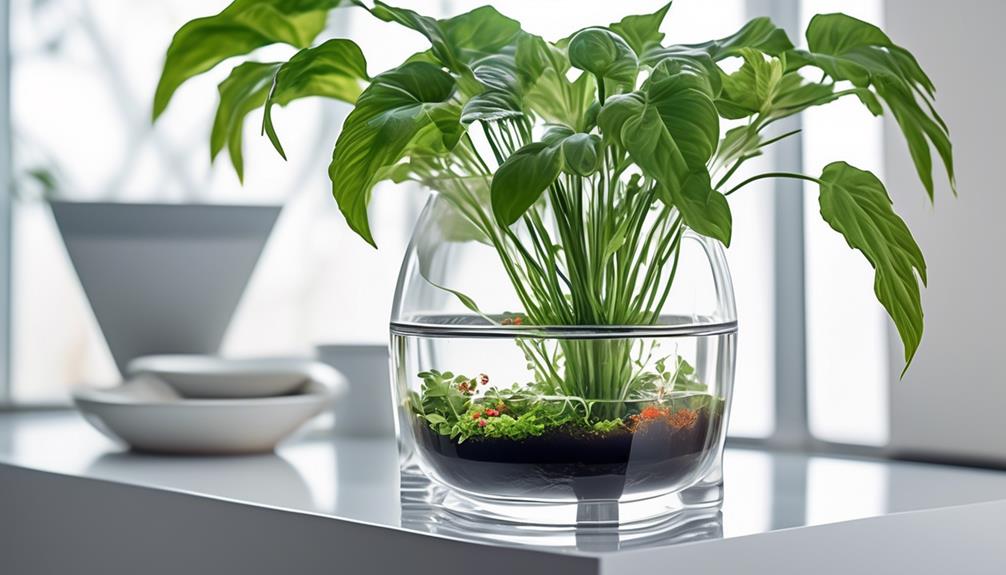
When it comes to the hydroponic principle, it's all about nutrient absorption and water reservoirs.
We'll explore how plants absorb essential nutrients directly from water, eliminating the need for soil.
The water reservoir plays a crucial role in maintaining the optimal balance of nutrients and hydration for the plants.
Nutrient Absorption
- Utilizing a nutrient solution
- Self-watering flower pots facilitate direct absorption of essential minerals by plant roots
- Promotes healthy growth and development
- Nutrient solution delivered directly to roots
- Ensures consistent and adequate supply of essential elements
- Fosters optimal root development
- Roots constantly surrounded by nutrient solution
- Encourages efficient growth and spreading of roots
- Controlled delivery of nutrients prevents over or underfeeding
- Continuous access to essential minerals
- Enables plant to allocate more energy towards above-ground growth and flower production
- Enhances overall aesthetic appeal of the plant
Water Reservoir
The water reservoir in self-watering flower pots serves as a crucial component, ensuring a constant supply of water to the plant roots, thus maintaining the hydroponic principle of nutrient delivery.
This reservoir is designed to efficiently provide the necessary hydration to the plants through a capillary action. When the soil becomes dry, the roots, guided by the principle of plant hydration, draw water from the reservoir through a wicking system, ensuring consistent moisture levels.
This mechanism not only enhances watering efficiency but also prevents overwatering, as the plant can draw water as needed. By maintaining optimal moisture levels, the water reservoir promotes root health and overall plant growth.
Additionally, it minimizes water wastage and reduces the frequency of manual watering, making it a sustainable and convenient solution for plant care.
Material Selection
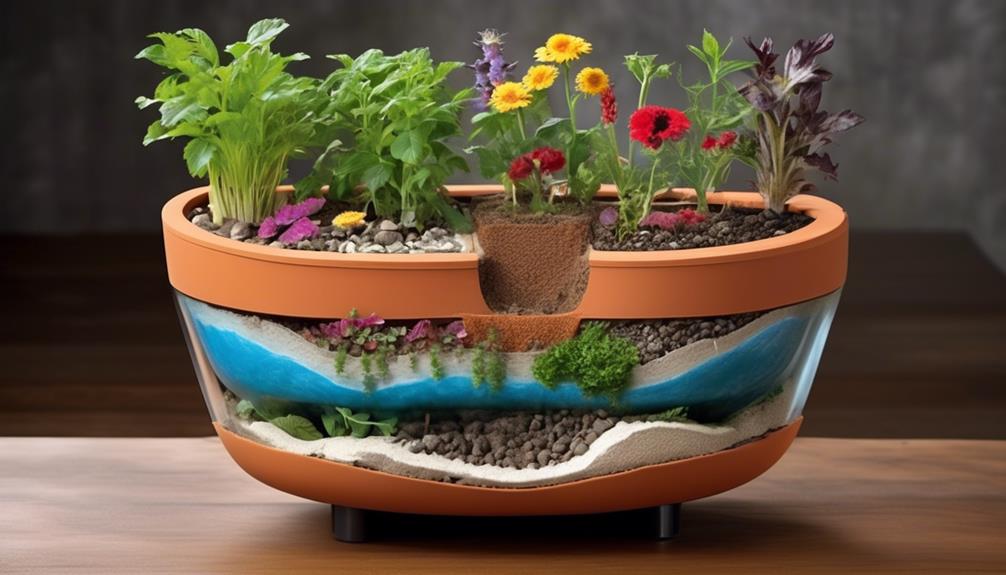
Selecting the appropriate materials is crucial in ensuring the effective functionality and durability of self-watering flower pots. Material compatibility and design considerations play a significant role in the overall performance of the pots.
When choosing materials for self-watering flower pots, several crucial factors must be taken into account:
- Porosity: The material used should be sufficiently porous to allow water to move from the reservoir to the soil while preventing waterlogging.
- Durability: Selecting durable materials is essential to ensure the longevity of the self-watering pots, especially when exposed to outdoor conditions.
- Non-toxicity: It's important to use materials that are non-toxic to plants and safe for the environment to avoid any potential harm.
- Thermal Insulation: Materials with good thermal insulation properties help regulate soil temperature, which is crucial for plant growth and root health.
Careful consideration of these factors when selecting materials for self-watering flower pots is imperative to ensure optimal performance and longevity. By choosing the right materials, we can create self-watering pots that effectively support plant growth while maintaining durability and functionality.
Maintenance Tips

To maintain self-watering flower pots effectively, regularly inspecting the water reservoir and ensuring proper drainage is essential. For container gardening, it's crucial to monitor the water level in the reservoir. Check the reservoir at least once a week, or more frequently during hot, dry weather. If the water level is low, refill it to ensure a continuous water supply for your indoor plants.
Additionally, it's important to clean the reservoir every 1-2 months to prevent the buildup of algae, which can clog the system and affect water distribution. To clean the reservoir, empty it completely, scrub it with a mild detergent, rinse thoroughly, and allow it to dry before refilling.
Proper drainage is also vital for the health of your plants. Ensure that the drainage holes in the pot are clear and unobstructed to prevent waterlogging, which can lead to root rot. Regularly inspect the soil moisture to adjust the watering frequency according to the specific needs of your indoor plants.
Frequently Asked Questions
Can Self-Watering Flower Pots Be Used for All Types of Plants, or Are There Specific Plants That Work Best With This System?
Self-watering flower pots can be used for a variety of plants, but certain species may thrive better with this system. Plant compatibility depends on the specific water and nutrient needs of each type.
Optimal conditions are essential for promoting plant health, and self-watering pots can help maintain consistent moisture levels. Understanding the watering frequency and adjusting it according to the plant's requirements is crucial for successful growth and overall well-being.
How Often Do I Need to Refill the Water Reservoir in a Self-Watering Flower Pot?
We refill the water reservoir in our self-watering flower pots based on the plant's needs and the water level indicator.
It's crucial to prevent overwatering and ensure compatibility with different plant types.
For outdoor use, we consider climate adaptation and adjust the refilling frequency accordingly.
The system's technical aspects allow us to master the art of keeping our plants thriving, while the scientific approach ensures optimal hydration for our green companions.
Are There Any Potential Drawbacks or Limitations to Using Self-Watering Flower Pots?
Potential drawbacks of self-watering flower pots include:
- Maintenance issues such as cleaning the reservoir and monitoring water levels.
- Some models may be more expensive than traditional pots, impacting cost.
- Aesthetically, the visible water reservoir may not suit all design preferences.
However, the benefits of consistent moisture levels and reduced watering frequency often outweigh these drawbacks for many gardeners.
Can Self-Watering Flower Pots Be Used Outdoors, or Are They Only Suitable for Indoor Use?
Yes, self-watering flower pots can be used outdoors, and they're suitable for outdoor use. The outdoor suitability of these pots depends on factors such as the material and design.
They can help regulate watering frequency and maintain the moisture levels of the soil, which is beneficial for outdoor plants, especially during hot and dry weather conditions.
Are There Any Special Considerations or Adjustments Needed When Using Self-Watering Flower Pots in Different Climates or Environments?
When adjusting watering frequency in different climates, consider the moisture retention properties of the pot material.
In dry environments, pots made of porous materials like terracotta may require more frequent refills.
Conversely, in humid climates, non-porous materials like plastic may necessitate less frequent watering.
Understanding the interaction between pot material and environmental conditions is crucial for optimizing the self-watering system's performance across different climates.
Where Can I Find Self Watering Flower Pots at Home Depot?
You can find self watering flower pots at Home Depot in the gardening section. These innovative pots come in various sizes and styles, making it easy to keep your plants hydrated without constant watering. Visit your local Home Depot and explore their selection of self watering flower pots to simplify your gardening routine.
Conclusion
In conclusion, self-watering flower pots work by utilizing several mechanisms and principles. They include capillary action, a reservoir system, wicking mechanism, soil moisture control, root absorption, osmosis process, and the hydroponic principle.
These pots are designed to reduce watering frequency and maintain optimal moisture levels for plant growth.
Interestingly, studies have shown that self-watering pots can reduce water usage by up to 80%, making them an eco-friendly and efficient option for plant care.

